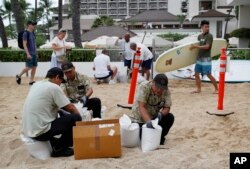Hurricane Lane soaked Hawaii with more than 50 centimeters (19 inches) of rain in 24 hours, and forecasters warned some areas could see up to 80 centimeters (31 inches) before the storm turns westward over the weekend.
The National Weather Service said Lane was not projected to make a direct hit on the islands.
“You do not need a direct strike to have major impacts from a hurricane this strong,’’ said Steve Goldstein, a meteorologist at the National Oceanic and Atmospheric Administration in Washington.
The center of the Category 4 storm was predicted to move close to or over portions of the main islands later Thursday or Friday, bringing dangerous surf of 6 meters (19 feet), forecasters said.
From Oahu to the Big Island, schools, businesses and government offices closed and residents stocked up on goods and boarded up their homes.
The storm, packing sustained winds of 230 kilometers per hour (142 mph), has been wavering between Category 4 and Category 5 strength. It was about 322 kilometers (200 miles) south of Kailua-Kona Thursday and moving northwest toward other islands.
President Donald Trump declared a state of emergency Wednesday and “ordered Federal assistance to supplement state and local response efforts,” a White House statement said.
The National Weather Service warned Hawaiians to expect flash flooding and landslides, with total rain accumulation of more than 50 centimeters (19 inches). The service predicted “excessive rainfall” will result in “significant and life-threatening flash flooding and landslides.”
Governor David Ige has signed an emergency proclamation to “provide relief for disaster damages, losses and suffering” caused by the hurricane. The proclamation declares the counties of “Hawaii, Maui, Kalawao, Kauai and the City and County of Honolulu disaster areas for the purpose of implementing emergency management functions,” his office said.
The hurricane forced the U.S. Navy to begin moving its ships and submarines away from the islands, according to Navy Rear Adm. Brian Fort. He said Wednesday that all ships not currently undergoing maintenance are being moved out of Pearl Harbor and will be positioned to help respond after the storm, if needed.
The central Pacific gets fewer hurricanes than other regions, with about only four or five named storms a year. Hawaii rarely gets hit.
But longtime Hawaii residents were reminded of the destruction caused by Hurricane Iniki in 1992 that made landfall on Kauai island as a Category 4 storm. It killed six people and caused $1.8 billion in damage.












